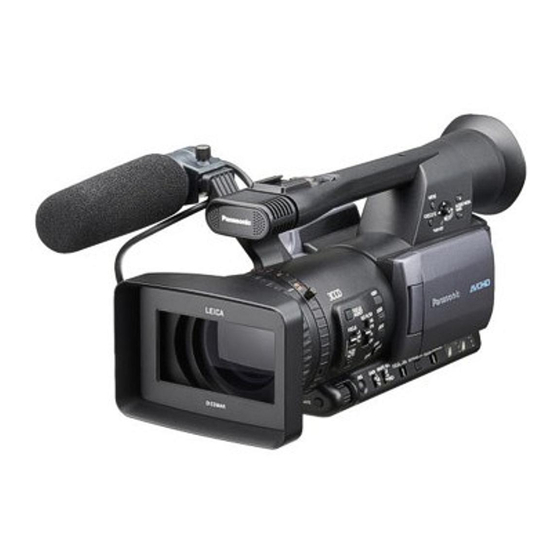Panasonic AG-HMC150 Manuel de l'utilisateur - Page 31
Parcourez en ligne ou téléchargez le pdf Manuel de l'utilisateur pour {nom_de_la_catégorie} Panasonic AG-HMC150. Panasonic AG-HMC150 35 pages. Avchd camcorder
Également pour Panasonic AG-HMC150 : Brochure & Specs (8 pages), Menu Information (20 pages), Brochure & Specs (12 pages), Brochure (16 pages), Manuel du produit (22 pages), Instructions de base (20 pages)

Jump cut. An abrupt transition between shots which
disrupts (often deliberately) the continuity of time or
space within a scene. When cuts are made between
shots that don't have at least a 30˚ angle change, they
appear more as jumps rather than seamless cuts. Jean-
Luc Godard's Breathless introduced a whole new way
of thinking about the jump-cut.
Kilobyte. One thousand bytes. Actually 1,024 bytes
because computer storage is measured using base 2
(binary) number system with each digit's value based
on a power of 2 (1, 2, 4, 8, 16, 32, 64, 128, 256,
512, 1,024) rather than base 10 based on powers of
10 (1, 10, 100, 1,000) which is our everyday number
system.
LCD. A solid state technology used for image display.
See CRT.
Lens. An assembly of several pieces of precision
ground glass through which light rays are focused to
create an image on lm or imaging device. See
normal lens, telephoto lens, wide-angle lens, zoom
lens.
Lens aperture. See Aperture.
Letterbox. Placing a wide screen image (e.g. 16x9,
1;85:1, or scope) within a conventional (4x3) frame
by placing black bands at the top and bottom of the
screen. See Curtain.
Limiter. A limiter is a type of audio compressor that
limits the level of the audio signal to a particular
threshold. A limiter prevents any additional gain
above the threshold, protecting you against occasional
signal peaks (that cause clipping and distortion). See
also Automatic Gain Control.
Line level. In most cases, prosumer cameras provide
a choice of microphone or line level audio inputs.
Line level denotes the strength of an audio signal
used to transmit analog sound between audio
components such as a mixer and a video camera. In
contrast microphone level signals are much weaker.
Line level is less susceptible to interference compared
to microphone levels. See microphone level.
Long shot (LS). A shot that shows a fairly wide view
of a subject within its setting. A long shot of a person
typically includes his entire body and much of his
surroundings.
Long take. A take (shot) of lengthy duration.
Low-angle shot (L/A). A shot in which the camera
is tilted up at the subject.
Introduction to the Panasonic AG-HMC150 AVCHD camcorder (rough draft)
Luminance. 1. A measure of brightness. 2. e
portion of a video signal that encodes brightness
information (not color). See Chrominance.
Masking. Blocking out part of an image, usually at
the edges of the frame, thus altering the size or the
shape of the frame projected on the screen. See
Curtains, Letterbox.
Master shot. A single shot, usually a long shot or a
full shot, which provides an overview of the action in
a scene.
Megabyte. 1 million bytes.
Medium shot (MS). A relatively close shot that
shows part of a person or object in some detail. A
medium shot of a person typically shows their upper
body only.
Microphone level. In most cases, prosumer cameras
provide a choice of microphone or line level audio
inputs. Microphone level denotes the strength of an
audio signal used to transmit analog sound between a
microphone and a video camera. In contrast line level
signals are much stronger. Microphone level signals
are more susceptible to interference compared to line
levels. See line level.
MPEG. Moving Picture Experts Group. A standard
for compressing moving pictures. MPEG-1 uses a
data rate of 1.2 Mbps (Mega Bits per Second), the
speed of CD-ROM. MPEG-2 supports much higher
quality with a data rate (a.k.a. bit rate) from 2 to 10
Mpbs. MPEG-2 is the format speci ed in the DVD
standard and is also used as a camera recording
format (e.g. HDV). MPEG-4 is a lower data rate
version used for web video and mobile devices. For
web video, the H.264 codec within a MPEG-4
wrapper is widely used.
NTSC. National Television Standards Committee.
e analog broadcast television and video standard in
use in the United States. NTSC broadcast is
scheduled to be turned off in 2009. Consists of 525
horizontal lines at a eld rate of 60 elds per second.
(Two elds equals one complete Frame). Only 487 of
these lines are used for picture. e rest are used for
sync or extra information such as VITC and Closed
Captioning.
Normal lens. A camera lens that shows a subject
without signi cantly exaggerating or reducing depth
of eld in a shot. Neither wide nor telephoto,
typically has a 45 degree or so angle of view.
NXCAM. A high de nition video format used by
some Sony cameras, capable of recording up to
http://kino-eye.com/dvb/
31 / 35
